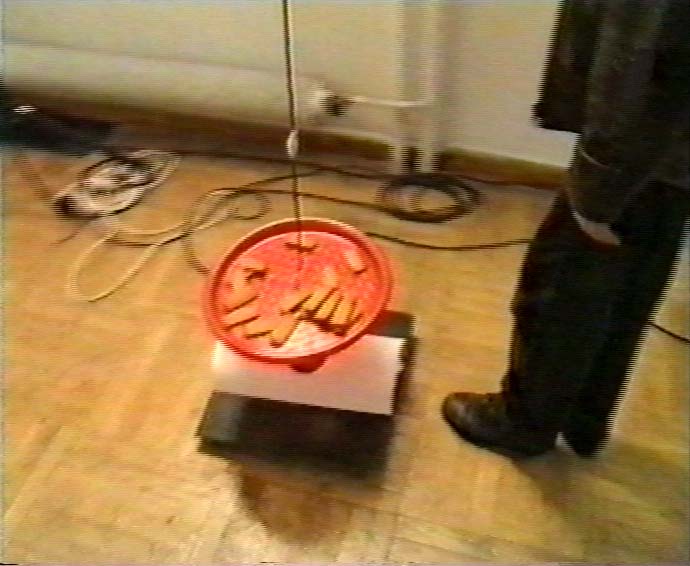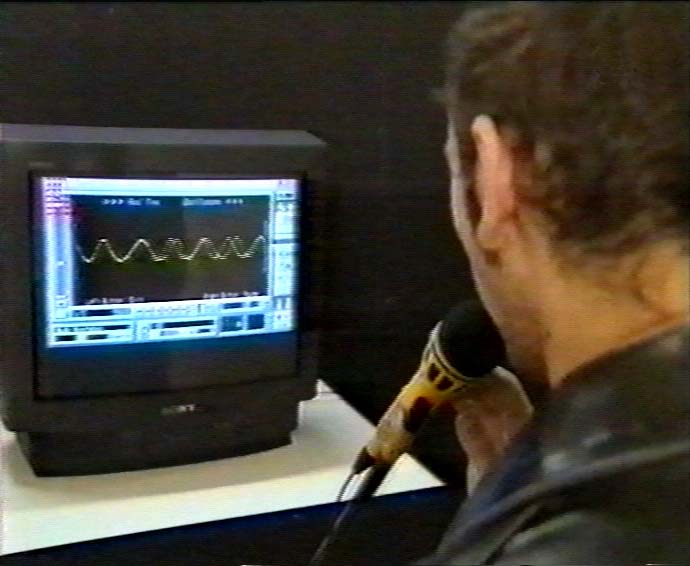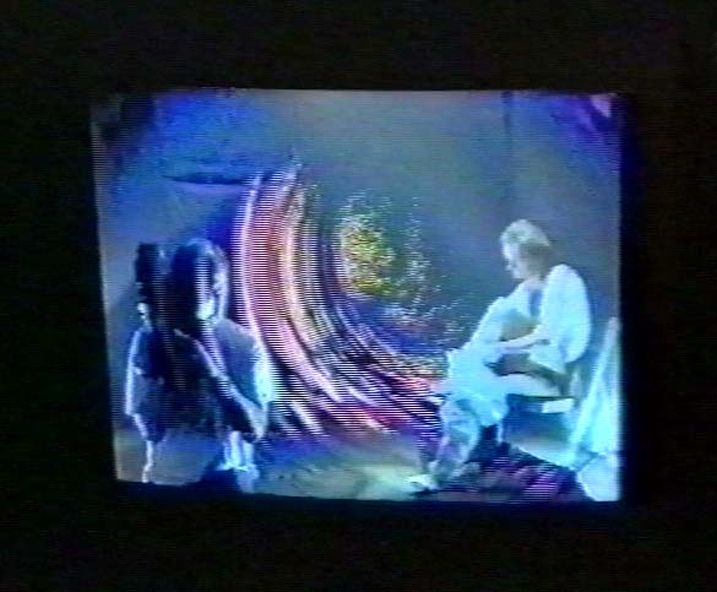
Intuited Space
Krzysztof Mazur
MULTI-MEDIALNE SENSITIVITY GLOBAL ART Bunker Art Gallery May 1996 Cracov
Programme 1995/96
The subject I have taken up in this work is, as it were, my reflection on Man and his new organization of space, as provided by modern technology. This is connected with the shaping of a new sensitivity in how such space is experienced, decoded, and understood. A particular from of perceiving space is coming into begin. It can even be started that, along with this new space, Man has acquired and shaped his own imagination and understanding of space.
I have titled my work "Intuited Space". But still, it is the human person, his presence, his liberated energy which constitute the real interior of that space. The person passing through the space experiences various sorts of impressions prompted by this space, which is set into motion by his presence and action. At the same time, the persons going through this experience learn to move in this space, which gives them the opportunity to choose and to interact with the space itself. But what would constitute the nature of this space? In the light of the traditional understanding, this is a certain small area, which allows for nothing more than to move around within it. And this real space is marked out by such sensations as sound, sight, touch, or smell, which are connected with begin within it. These evoked impressions have the task ex hypothesi of transcending the physical possibilities of the area in which they are located.
The work is made up of two parts. In the first part, which occupies a surface area of 10-20 meters, there are scattered sensors which detect the presence of someone. They react to infrared, visible light, radio waves, or touch. These sensors, after the signal has been transferred, start up devices which evoke impressions that act on the senses, such as light and sound effects, the movement of objects, or olfactory impressions. A person who enters into the "sensitivity zone" of this space is subject to media manipulation, but this is only apparent manipulation. Experiencing, as it were, his own presence, he learns to move in this area, and rather quickly goes from begin a passive object under manipulation to begin the active agent and operator, deciding on the choice of the effects offered. To put it another way, the human person here turns on and adjusts certain actions, which after the first spontaneous recognition he could assemble in meanings that are already not accidental, but his own.
In such conditions a dialogue is initiated between the work and the viewer. Thus the sound sensor picks up all the sound that come to it, and uses an electronic apparatus to change them into sound ware graphs, which are displayed on the monitor. The infrared sensor detects all movement within the given area, and then initiates the emission of an odor. The infrared barrier reacts with sound and light as soon as its thin invisible line is crossed. On the floor there are fields distributed, arranged on the model of a children's game. The notes of the octave c d e f g a h c are assigned to each field, and are actuated when the particular pole is entered. Photocells start up sound and light effects, which are modulated by the quantity of light emitted by the approaching person. An object which reacts by running away from anyone who approaches it is moving around the whole area.
The second part of the work is a construction, a studio for artificial scenography. A given person is brought into an area tinted in a uniform shade or color that is neutral for visual processing. This is intended to make a contrast between this person and the surroundings, as though cutting him out of the external area. His real presence in the space, however, takes place on the monitor screen. This process happens in such a way that the person who finds himself in the studio is monitored by a video camera. At the same time, the image of this person is electronically joined with a second picture, artificially added on to it. Nevertheless, the person in the studio has a continuous view of the final effect, which makes it possible at any time for him to react immediately to the current situation. Here, too, there is initiated a particular multimedia interactive dialogue between the work and the viewer, except that what is subject to manipulation this time is the electronic information about the picture.
The mixing of pictures is done by using two methods. The first, called "chrome key" (popularly known as "blue box") involves associating the uniform color of the background with a specified frequency, which becomes, as it were, transparent for another picture introduced in its place. The rest of the original picture, of a color different than the background, remains unchanged. The second method differs only in the respect that the area of transparency is identified differently. This time it is not the color which marks that transparency, but the lightness and darkness of a given area. For example, when we place something light against a dark background, that dark background becomes transparent for another picture, while the lighter remainder is unchanged.
In the content itself of manipulated picture I gear the psychological effect of this scenography to the subjective reaction of the person. I use gender reversal in a given situation, mixing, for example, the picture of a man with a woman's picture introduced into the scenography, or vice versa. Or I use symbolism of shapes connected with gender differences. I use not only pictures taken from reality, but also computer generated pictures. This results from the more elastic possibilities to adapt the depth of space connected with perspective. I expect the persons participating in this experience to initiate active dialogue, and the further development of my work is tending in that direction.
In signing my work, I wish to express a certain personal intuition, reflecting the reality, as it were, of our times, since a small physical space can be an assemblage of experiences bearing certain communicative information, which, thanks to elastic manipulation, develops our imagination to perceive a space which is already completely new.
Cracov 19 11 1995






Programme 1995/96
The subject I have taken up in this work is, as it were, my reflection on Man and his new organization of space, as provided by modern technology. This is connected with the shaping of a new sensitivity in how such space is experienced, decoded, and understood. A particular from of perceiving space is coming into begin. It can even be started that, along with this new space, Man has acquired and shaped his own imagination and understanding of space.
I have titled my work "Intuited Space". But still, it is the human person, his presence, his liberated energy which constitute the real interior of that space. The person passing through the space experiences various sorts of impressions prompted by this space, which is set into motion by his presence and action. At the same time, the persons going through this experience learn to move in this space, which gives them the opportunity to choose and to interact with the space itself. But what would constitute the nature of this space? In the light of the traditional understanding, this is a certain small area, which allows for nothing more than to move around within it. And this real space is marked out by such sensations as sound, sight, touch, or smell, which are connected with begin within it. These evoked impressions have the task ex hypothesi of transcending the physical possibilities of the area in which they are located.
The work is made up of two parts. In the first part, which occupies a surface area of 10-20 meters, there are scattered sensors which detect the presence of someone. They react to infrared, visible light, radio waves, or touch. These sensors, after the signal has been transferred, start up devices which evoke impressions that act on the senses, such as light and sound effects, the movement of objects, or olfactory impressions. A person who enters into the "sensitivity zone" of this space is subject to media manipulation, but this is only apparent manipulation. Experiencing, as it were, his own presence, he learns to move in this area, and rather quickly goes from begin a passive object under manipulation to begin the active agent and operator, deciding on the choice of the effects offered. To put it another way, the human person here turns on and adjusts certain actions, which after the first spontaneous recognition he could assemble in meanings that are already not accidental, but his own.
In such conditions a dialogue is initiated between the work and the viewer. Thus the sound sensor picks up all the sound that come to it, and uses an electronic apparatus to change them into sound ware graphs, which are displayed on the monitor. The infrared sensor detects all movement within the given area, and then initiates the emission of an odor. The infrared barrier reacts with sound and light as soon as its thin invisible line is crossed. On the floor there are fields distributed, arranged on the model of a children's game. The notes of the octave c d e f g a h c are assigned to each field, and are actuated when the particular pole is entered. Photocells start up sound and light effects, which are modulated by the quantity of light emitted by the approaching person. An object which reacts by running away from anyone who approaches it is moving around the whole area.
The second part of the work is a construction, a studio for artificial scenography. A given person is brought into an area tinted in a uniform shade or color that is neutral for visual processing. This is intended to make a contrast between this person and the surroundings, as though cutting him out of the external area. His real presence in the space, however, takes place on the monitor screen. This process happens in such a way that the person who finds himself in the studio is monitored by a video camera. At the same time, the image of this person is electronically joined with a second picture, artificially added on to it. Nevertheless, the person in the studio has a continuous view of the final effect, which makes it possible at any time for him to react immediately to the current situation. Here, too, there is initiated a particular multimedia interactive dialogue between the work and the viewer, except that what is subject to manipulation this time is the electronic information about the picture.
The mixing of pictures is done by using two methods. The first, called "chrome key" (popularly known as "blue box") involves associating the uniform color of the background with a specified frequency, which becomes, as it were, transparent for another picture introduced in its place. The rest of the original picture, of a color different than the background, remains unchanged. The second method differs only in the respect that the area of transparency is identified differently. This time it is not the color which marks that transparency, but the lightness and darkness of a given area. For example, when we place something light against a dark background, that dark background becomes transparent for another picture, while the lighter remainder is unchanged.
In the content itself of manipulated picture I gear the psychological effect of this scenography to the subjective reaction of the person. I use gender reversal in a given situation, mixing, for example, the picture of a man with a woman's picture introduced into the scenography, or vice versa. Or I use symbolism of shapes connected with gender differences. I use not only pictures taken from reality, but also computer generated pictures. This results from the more elastic possibilities to adapt the depth of space connected with perspective. I expect the persons participating in this experience to initiate active dialogue, and the further development of my work is tending in that direction.
In signing my work, I wish to express a certain personal intuition, reflecting the reality, as it were, of our times, since a small physical space can be an assemblage of experiences bearing certain communicative information, which, thanks to elastic manipulation, develops our imagination to perceive a space which is already completely new.
Cracov 19 11 1995












